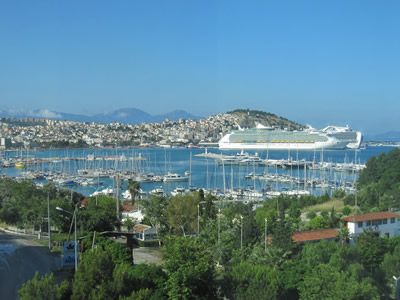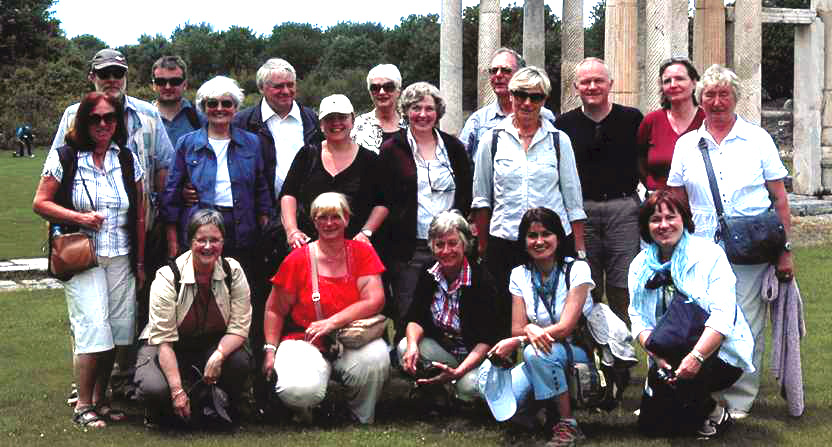
Classic Turkey trip, 2012
INTRODUCTION
HOME :
turkey trip Istanbul I Istanbul II Istanbul III Istanbul IV Bursa Troy Pergamum Sardes - Pamukkale Aphrodisia Ephesus Priene Didyma MiletCapitels
| In June, 2012 Birgit and I visited Turkey. For Birgit this was her sixth or seventh trip to Turkey, for me really the first visit, if one ignores a very brief stay in Istanbul for a conference about ten years ago. This was a special trip. Although we did spent three days in Istanbul and Bursa visiting some important sites of the Ottoma empire; our primary purpose was a "study trip" to the classic sites of turkey: Cities like Troy; Ephesus; Aphrodisia; Pergamum; Sardis; Priene; Didyma; and Miletus. Which means I might as well call it the "White Rock and Ruins Trip" (as opposed to the "Red Rock and Ruins" trip Nick and I took recently through Arizon; New Mexico; Colorado and Utah. The picture below shows the bay of Kuşadasi, a popular | ||
 |
beach resort. Here we stayed for the last three days of our tour in a very elegant beach hotel. Kuşadasi today is a tourist hub, but its history reaches back into antiquity. During the glory days of Ephesus Kuşadasi was known as "Neapolis" and was under the rule of Ephesus. During the middle ages, after Ephesus' harbor silted up, Kuşadasi was renamed "Scala Nova" and became an important port and trading city for the Republics of Genoa and Venice. In 1413 it was captured by Sultan Mehmet I and has since belonged to the ottoman empire (now the Republic of Turkey) At one time in the not quite recent past it was known as a charming fishing village, but now it is a major tourism center. However, what you see here in the picture on the left: cruise ships; sail boats; lolling on the beach snorkeling in the beautiful clear waters of the Aegeian sea; is not really what we got: Oh, we SAW the ships, etc. from our hotel as you can see from the picture on the left. BUT ours was NOT a "sun and fun" trip as the guide book describes a stay in Kuşadasi. | |
| We got to look at the cruise shipsand people lolling around the pool or frolicking in the surf before 8 am and/or after 7 pm. In between we were on the bus or hiking up and down montains covered with bits and pieces of broken marble or stood listening to our very good and highly knowledgeable tour guide. Too bad I did not bring a tape recorder - I missed the part where we were told that there would be a quiz after class! We were a small group, Fifteen live in Germany; two in Namibia; one in Switzerland; and me in the US. We all spoke German, but with slightly different accents, something I always enjoy hearing. More importantly, we all got along well. The group picture shows Birgit crouching in front | |
|
 |
on the left, me standing in the middle in the back. Our tour guide "call me Ayşe" since her proper name would have been mouthful for us (Ayşegül Vaizoglu) is the second from the right in front of our group picture. She was not only charming; patient; extremely well organized; but also really knows her stuff. Additionally, Birgit and I agreed with her political views. She grew up in a Turkey essentially created by Kemal Mustafa Atatürk . Although his image (see picture on the left) is still hanging in houses, restaurants, and all official buildings, it is not clear whether his secular Turkey will survive under the influence of the re-islamiziation of Turkey under the Erdogan government. The most obvious signs of this are, of course, the dramatic increase of women wearing the kerchief and what look like floor length raincoats, even in hot weather. Kemal Mustafa was a military hero during WWI and the war of independence in 1922. He led Turkey to its only victory in WWI in the disastrous Gallipoli campaign and in the decisive battle in the war of independence against Greece in 1922. After that, Kemal Mustafa became the leader of the "young turks" who were determined to modernized Turkey. They abolished the califat and the sultanate, creating the modern, secular Republic of Turkey. In appreciation for what he had done for the country the Turkish Parliament in 1934 bestowed on him the honorific Atatürk (Father of turks) . |
|
